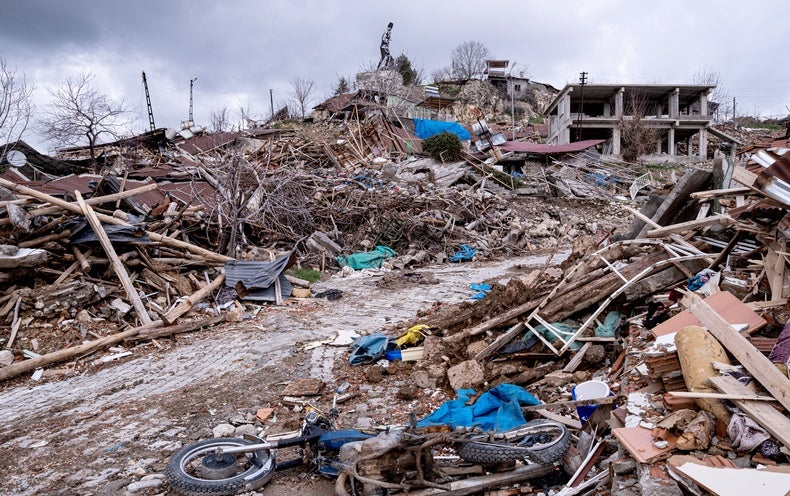The earthquake that has destroyed parts of Türkiye and Syria is a tragedy for millions of families, including my own. One of the worst hit regions—around the ancient city of Antioch—is where my father’s family has lived for generations. This disaster has killed thousands of people and affected millions of others. Now that the last presumed survivors have been found, the region faces many other problems, including enormous amounts of debris from collapsed buildings, roads, and the like. This material is estimated to weigh up to 210 million tons—enough to cover Washington, D.C. four feet deep, or build a mound as tall as Mount Erciyes, a large volcano in Türkiye.
A 2017 U.S. congressional report highlighted post-disaster debris management as “one of the greatest challenges” on the path to recovery and rebuilding. These same challenges now confront Türkiye and Syria. The massive quantities of post-disaster debris, the desire and need to clean up quickly, and the high costs of debris-removal operations can lead to many missteps with dangerous consequences.
Our research on debris management highlights planning as a key driver in reducing long-term negative effects on the health of people and ecosystems. The plans need to identify and prepare disposal sites, establish capacity for recycling and provide guidelines for residents, contractors and local governments on how to safely manage the materials they encounter.
Debris removal can constitute around one third of disaster recovery costs and last for months or years. When not managed properly, unlined landfills, rivers, coasts or other open areas may become dumping sites for potentially hazardous materials. This contributes to the contamination of water and soil, alters the flow of rivers, and poses a huge threat to human, plant and animal life.
During the first 24 to 72 hours after a major disaster strikes, the priority in debris management is on clearance, to enable access to search and rescue, evacuation or the delivery of supplies, for example, by pushing debris out of roadways. The focus then shifts to collection—transporting debris to temporary collection areas. The final step is disposal, with multiple aspects such as sorting and separation, recycling, landfilling in designated areas, incineration, etc. The decisions about how to handle debris at each stage are complex, with significant long-term social and environmental consequences. For example, if and how much sorting is done during clearance and collection can impact the speed of search and rescue efforts, the cost and duration of debris management operations, and the eventual destination of the debris.
Where to place debris in the short-term is a significant social and environmental decision. After the Haiti earthquake, Rivière Grise became a dumping ground, especially for construction debris. After Hurricane Katrina, an emergency landfill opened in Versailles (a neighborhood in New Orleans expanded by Vietnamese refugees), and that decision led to numerous protests over environmental concerns.
In Türkiye, mixed into the construction waste of fallen buildings are asbestos and other harmful chemicals, along with household appliances and electronics. People and environmental groups have raised concerns about the potential hazards hidden in these mountains of debris, parts of which have been dumped in or near residential areas, agricultural fields, riverbeds or wildlife sanctuary areas. The Turkish government announced its debris management plans mentioning the separation, recycling, reuse for construction or proper disposal of debris. However, the execution of these plans has been challenging; government officials have welcomed input from the public if they observe erroneous or illegal practices by contractors.
There are three key steps in improving the efficiency and effectiveness of debris management activities: planning; technology and/or data driven decision-making in implementation; and oversight. To best prepare, the planning process needs to engage many organizations and experts from a broad range of fields including geology, civil and environmental engineering, city and regional planning, public health, industrial and systems engineering, and so on. Oversight during the execution is crucial to ensure that the plans are carried out properly or revised as needed.
Post-disaster response involves multiple stakeholders (e.g., governments, nongovernmental organizations, contractors), further emphasizing the importance of collaborative predisaster planning along with deployment exercises conducted during “normal” times on potential plausible disaster scenarios. In short, a “systems approach” is essential, considering the linkages and the cascading impact of decisions ranging from planning to the logistics of the implementation.
Data and technology can help in all aspects of debris management. For example, the Hazus tool developed by FEMA generates risk estimates and informs planning decisions of local governments, and EPA’s Disaster Debris Recovery Tool provides information for over 20,000 debris management facilities. Technology also enables collecting and sharing data or mapping the status of an area, to help assess the type, amount and location of post-disaster debris. Unfortunately, such tools or technology are not available in many vulnerable areas around the world. This is an area where collaboration across nations and governments, possibly with support from funding agencies and coordination by nongovernmental organizations, could significantly benefit planning efforts and reduce the negative impact of future disasters.
For thousands of years, the city where my father’s family comes from has been home to a mosaic of people from many cultures and religions, and it has been heartbreaking to see it turned to rubble. Some of the oldest relics of civilization might be lost forever. Amid the rush towards recovery and rebuilding, debris management must take center stage, and hopefully will not cause a different kind of devastation for future generations.
This is an opinion and analysis article, and the views expressed by the author or authors are not necessarily those of Scientific American.

